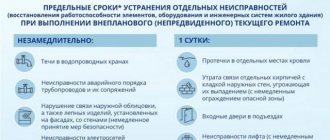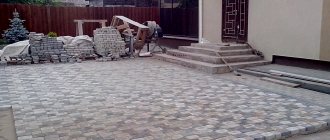Postings in HOAs - basic examples
All decisions made regarding common property are approved at a general meeting of homeowners by a majority vote.
To determine the number of votes that the owner of a residential premises has, it is necessary to take into account his share in the ownership of the common property. Modern practice shows that one of the most effective ways to manage an apartment building is an HOA. The organization of an established system for accounting for HOA operations is a prerequisite necessary to ensure the full functioning of the partnership and the fulfillment of its main tasks. In the article we will analyze specific aspects of accounting for HOAs and consider typical accounting entries in HOA enterprises using examples.
Account of wiring for major repairs in a homeowners' association
Cash receipts that are subject to and non-taxable must be accounted for separately. It is also important to ensure separate accounting of expenditures of funds received as targeted revenues. Therefore, the priority areas of work for an HOA accountant include drawing up cost estimates and distribution of costs, organizing analytical accounting of the organization’s costs.
- Receipt of invoice 86 credit of invoice 70 “Settlements with personnel for wages” - salaries to employees.
- Receipt of account 50 “Cash” debt of account 51 – receipt of money from the bank.
- Receipt of nominal account 10 “Materials” credit of account 50 – purchase of household supplies for cash.
Account of wiring for major repairs in a homeowners' association
The HOA keeps records of targeted funds in account 86 “Targeted Financing”. For account 86, it is necessary to open sub-accounts based on the sources of funds received. Let's consider the accounting of HOA fees, except for payments for housing and communal services, the accounting of which will be discussed below.
It is important to note that the partnership is obliged to ensure the maintenance of the common property of the apartment building as a whole, regardless of whether the share of such property belongs to a member of the HOA (TSN) or not. Consequently, in order to ensure the fulfillment of such an obligation in relation to the owners of premises who are not members of the HOA (TSN), the partnership must separately enter into an agreement with each of them for the maintenance and repair of common property in an apartment building.
Free legal assistance
Her responsibilities include:
- monitor the condition of the entrusted object and carry out its repairs;
- perform other work related to building management.
- provide utility services to home owners;
The management company's accountant makes payments for utility services using balance sheet account 76 “Settlements with debtors and creditors” separately for each subscriber and type of service. The management company's income received as a fee for services is credited to balance sheet account 90 and is considered revenue by type of activity.
Costs are covered by receiving fees for housing maintenance and repairs. Info In the accounting of a housing and communal services management company, if transactions under the simplified tax system are taken into account, then 3 and 7 will not be included in the accounting. As for VAT benefits for management companies located on OSNO, they are reflected in accounting as follows (there will be no postings 3 and 7): D20 K19 – VAT on purchased resources is reflected as part of their cost.
Account of wiring for repairs from capital repairs in the homeowners association
Debit 60 Credit 51 (55) – payment was transferred to a third-party contractor performing repairs; Debit 20 Credit 60 – expenses for repairs performed by third-party contractors are reflected; Debit 19 Credit 60 – input VAT presented by contractors is taken into account; Debit 20 Credit 19 – the amount of VAT claimed by contractors is attributed to the costs of repairs carried out by contract; Debit 20 Credit 70 (69, 10...) – reflects the costs of repairs carried out by the homeowners association (TSN) on their own; Debit 86 Credit 20 – reflects the expenditure of targeted financing; Debit 86 Credit 68 subaccount “Calculations for VAT” – VAT is charged for repair work carried out by the HOA (TSN) on its own.
We recommend reading: Contract for the Purchase and Sale of Land in Gardening
Entry, membership, share fees, donations, and funds in reserve for repairs are not subject to taxation. Tax accounting of amounts received as income in HOAs is no different from accounting in other organizations engaged in commercial activities.
Postings of the management company
The housing and communal services management organization does not provide utility services, but only ensures their provision. In practice, this means that the management company does not have any profit left at its disposal after settlements with the RSO.
How to take into account in accounting. accounting for management utilities: with attribution to account 90, or as transit payments to account 76? The procedure for recording the provision of utility services in accounting depends on whether the management company independently provides services or is an intermediary under an agency agreement. If the management company provides services independently, make the following entries: Debit 20 Credit 60 - reflects the costs of the services of the resource supplying organization in providing a utility resource; Debit 19 Credit 60 – input VAT is reflected; Debit 68 subaccount “Calculations for VAT” Credit 19 – accepted for deduction of input VAT (if the management company does not apply VAT exemption); Debit 20 Credit 19 – input VAT is reflected as part of the costs of services of a resource supplying organization for the provision of a utility resource (if the management company applies VAT exemption); Debit 62 Credit 90-1 – reflects the sale of services to consumers; Debit 90-2 Credit 20 – reflects the cost of the service; Debit 90-3 Credit 68 subaccount “Calculations for VAT” – VAT is charged (if the management company does not apply VAT exemption); Debit 51 Credit 62 (76) – funds received from consumers (from the budget); Debit 76 Credit 62 – consumer debt for utility bills is offset (when paying for services using funds from the budget); Debit 60 Credit 51 – funds of the resource supplying organization were transferred.
This approach follows from the Instructions for the chart of accounts (accounts 20, 90). If the management company operates under an agency agreement, then reflect the transactions as follows: Debit 76 Credit 60 - reflects the debt of residents for services provided by the resource supply organization; Debit 76 Credit 90-1 – agency fee accrued under the management agreement; Debit 90-3 Credit 68 subaccount “Calculations for VAT” – VAT is charged on the amount of agency fees; Debit 50 (51) Credit 76 – payments received from the owners of residential premises; Debit 60 Credit 51 – funds from the resource supplying organization were transferred.
This follows from the Instructions for the chart of accounts (accounts 76, 90).
Rules for accounting in housing and communal services (nuances)
etc., wiring Dt 20 Kt 10 (60, 68, 69, 70, 71, 76, etc.).
Moreover, if the management company contains several divisions, each of which includes a larger or smaller number of houses, then cost accounting must be organized in the context of each division and each house. Example of account structure 20: Subconto 1 Subconto 2 Subconto 3 (Costs) Division 1 MKD 1 1. Sewerage 2. Water supply 3.
Heating 4. Electricity 5. Landscaping 6. Contents 7. Gas supply, etc. MKD 2 Division 2 MKD 3 MKD 4 MKD 5 Costs related directly to the management of each structural unit are collected on account 25 “General production expenses” according to expense items: depreciation, wages, insurance premiums, rent, etc.
All administrative costs for servicing the management apparatus are debited to account 26 “General business expenses”. By
Accounting for capital repairs in HOAs
The costs of major repairs cannot be recognized for the purposes of calculating the tax paid when applying the simplification, since they were incurred at the expense of targeted financing. At the same time, the organization is obliged to keep separate records of such income and expenses (clause 14, clause 1, article 251, clause 2, article 346.16, clause 1, article 252 of the Tax Code of the Russian Federation).
- account 86-2 “Targeted revenues for current repairs of common property”;
- account 86-3 “Targeted revenues for major repairs of common property”;
- account 86-3-1 “Targeted revenues for major repairs of common property from owners”;
- account 86-3-1 “Targeted revenues for major repairs of common property from the budget.”
The management company carries out routine repairs: profit taxation
Management companies provide utility services and work on the maintenance and current repairs of the common property of apartment buildings on the basis of a management agreement. Accountants and economists of management organizations often have a question about how to properly record revenue in accounting and tax accounting under account 90 “Sales”? We will try to figure this out in today's article. Cost of the management agreement In accordance with the Instructions for using the Chart of Accounts, analytical accounting for account 90 “Sales” must be kept separately, that is, for each type of work performed and services provided. In the payment documents, the work performed and services provided under the management agreement are detailed by the management specialist at his discretion.
Taxation of HOAs under the simplified tax system in 2019
- mandatory payments, entrance and other fees of HOA members;
- payments from homeowners who are not members of the HOA;
- income from the entrepreneurial activities of the HOA, aimed at fulfilling the goals, objectives and responsibilities of the HOA (Article 152 of the Housing Code of the Russian Federation);
- subsidies for the operation of common property, carrying out current and major repairs, providing certain types of utilities and other subsidies;
- other supply.
The HOA keeps records of targeted funds in account 86 “Targeted Financing”. For account 86, it is necessary to open sub-accounts based on the sources of funds received. Let's consider the accounting of HOA fees, except for payments for housing and communal services, the accounting of which will be discussed below.
Differences in carrying out housing and communal services work and HOAs
Very often, when choosing a way to manage a house, owners wonder whether to give preference to a management company or create an HOA. Since the board of the homeowners association is elected from among the residents, all repair issues are resolved jointly. Repair work will be carried out as needed, their frequency and timing, according to Article 145 of the Housing Code of the Russian Federation, will be decided by all members of the HOA (the list of work on current repairs can be found here). The partnership may enter into a repair contract with another organization or hire workers on its own.
When signing an agreement with the housing and communal services, current repairs and all housing and communal services are required to be provided by the management company. The advantage of cooperation with a management company is that the company employs professionals who have the skills and experience in handling such cases. However, the operating costs repairs are usually significantly more expensive than an HOA, and there are no reports on how funds were spent. Very often the management company does not fulfill its direct responsibilities for carrying out cosmetic repairs in the entrances.
Book of Postings for Overhaul in Homeowners' Association
Account 76-2 (operation 10) is used to increase the capital repair fund, reflected in the credit of account 86-3, at the expense of accounts receivable - future contributions from the owners in the event of receiving a credit (loan) necessary for capital repairs.
In accordance with paragraph 2 of Art. 251 of the Tax Code of the Russian Federation, funds received by a homeowners’ association or housing cooperative for the formation of a reserve for major repairs of common property represent targeted revenues. Therefore, in Table. 1, these funds are reflected in the credit of account 86 “Targeted financing” by type of income.
We recommend reading: Housing Program for Single Mothers
ACCOUNTING IN THE MC WITHIN THE FRAMEWORK OF THE MANAGEMENT AGREEMENT page 4
— opening a separate bank account for depositing funds from the fund;
— ensuring the safety of accumulated funds;
- use of the fund’s funds exclusively for their intended purpose, namely to pay for repair work, the list, deadlines and cost of which are approved by the decision of the OSS;
— transfer of fund assets to a new manager in the event of a change in the management method or management organization, etc.
In accounting, contributions payable by the owner to the repair fund are shown by posting Debit 76 Credit 86, which accurately characterizes the economic essence of this fact of economic life (business transaction):
— the funds of the repair fund are not the property of the management company and upon the occurrence of certain circumstances (expiration of the management agreement, change of the management company, change in the method of managing the house), they must be transferred to a new person who assumes the rights of manager of the apartment building, whose residents accumulate funds for future repairs. That is, they cannot be recognized either as part of revenue or as part of future income, at least until the obligation arises to repair common property using accumulated funds. Such an obligation arises only at the moment of agreement with the owners of the list of necessary works, the timing of their implementation and the procedure for financing. This is on the one hand. On the other hand, the accumulated funds meet the definition of an accounting object in the form of a source of financing, characterized as an existing and expected source of financial resources. Moreover, such resources, at the expense of which in the future the management company can fulfill its obligations (contractual and legally established) to carry out repair work necessary for the common property for the purpose of its proper maintenance. All these factors determine the use of account 86 “Targeted financing” in accounting;
— in accordance with the decision of the OSS and the regulations on the creation of a repair fund, the owners are obliged to make contributions for future repairs at a specified frequency, therefore, the management company has the right to demand the payment of these contributions, which indicates the need to recognize in accounting the receivables of the owners that are not related to current payments under the contract management (payment of fees for the maintenance of common property, traditionally taken into account when accruing it in the debit of account 62 “Settlements with buyers and customers”). That is why account 76 “Settlements with various debtors and creditors” is used.
Example. The owners of premises in the apartment building, with the participation of the management company, held a general meeting at which it was decided to form a repair fund. The monthly total contribution of owners to this fund is 20,000 rubles. The fund accumulates over two years. Then the owners make a decision on how to spend it - they approve the list of works and the deadlines for their completion, as well as the procedure for paying for the work performed. Payment discipline of owners is 80%.
In the working chart of accounts of the management company:
— subaccount 51-2 “Special current account” has been opened to account 51 “Current accounts”;
— to account 76 “Settlements with various debtors and creditors”, a subaccount 76-6 “Contributions to the repair fund” was opened;
— subaccount 86-1 “Repair Fund” has been opened to account 86 “Targeted Financing”.
During the period of accumulation of the fund, the following entries will be made in the accounting records of the management company:
┌────────────────────────────────────────────┬────────┬────────┬──────────┐
│ Contents of the transaction │ Debit │ Credit │ Amount, │
│ │ │ │ rub. │
├────────────────────────────────────────────┴────────┴────────┴──────────┤
│ Monthly for two years │
├────────────────────────────────────────────┬────────┬────────┬──────────┤
│Contributions to the repair fund have been accrued, │ 76-6 │ 86-1 │ 20,000 │
│payable by owners │ │ │ │
├────────────────────────────────────────────┼────────┼────────┼──────────┤
│Contributions to the repair fund have been transferred │ 51-2 │ 76-6 │ 16,000 │
│(RUB 20,000 x 80%) │ │ │ │
└────────────────────────────────────────────┴────────┴────────┴──────────┘
For tax purposes, the accumulation of owner funds in repair funds is preferential. Thus, at the time of accrual of contributions to the repair fund to the owners and at the time of their transfer to the current account of the management company, the amount of these contributions (both actually received and due for payment) is not subject to inclusion in the calculation of income tax in accordance with paragraphs. 14 clause 1 art. 251 Tax Code of the Russian Federation. According to it, targeted financing funds that are not recognized as income when determining the tax base include funds from the owners of premises in apartment buildings to finance repairs and overhauls of the common property of apartment buildings.
The specified funds are also not included in the VAT base, the basis is paragraphs. 1 clause 3 art. 162 of the Tax Code of the Russian Federation. It talks about funds received to form a reserve for current and major repairs of common property in the apartment building.
Thus, at the stage of accumulation of funds in repair funds created by decision of the OSS, management organizations recognize in accounting and reporting funds of targeted financing, which are such for profit tax purposes and are not included in the VAT base due to the special instructions contained in Chapter. 21 Tax Code of the Russian Federation.
4.3.2. Maintenance
Routine repair of common property is a complex of construction, organizational and technical work that is carried out in order to prevent premature wear, maintain performance indicators and operability, eliminate damage and malfunctions of elements of common property (without replacing the enclosing load-bearing structures, elevators) (clause 18 of the Maintenance Rules common property). Most often, performing routine repairs of common property does not require a long time and does not take more than one or two months. Transferring the result of such work to the customer (in our case, the owners of the premises in the apartment building) means that the current repairs have been completed, which means that revenue for this element of the management agreement should be recognized in accounting and all necessary taxes should be charged. Due to the fact that the majority of routine repair work is carried out within a short period of time, there is no need to discuss the choice of method of recognizing revenue for accounting purposes (upon completion of the work or as it is ready) - revenue is recognized upon completion of the work.
According to clause 2.3.4 of the Rules for the operation of housing stock and section. 4 Regulations on the organization and conduct of reconstruction, repair and maintenance of residential buildings, communal and social and cultural facilities VSN 58-88 (r) the frequency of routine repairs of apartment buildings is from three to five years. In this case, it is advisable to carry out individual repair work in the context of annual plans. Thus, in any management organization a situation may arise in which some work on routine repairs of common property will be planned and carried out annually, and some - once every three to five years with preliminary accumulation of funds. Therefore, we will further pay attention to both options.
Current repairs are planned and carried out annually
If routine repairs are carried out annually, then their list and cost are discussed and approved at a general meeting of owners. Consequently, the costs of performing routine repairs are planned and included in the price of the management contract for the year. The price of the management agreement is the basis for calculating the payment for residential premises in terms of the corresponding element (obtained by dividing the price by 12 months), which is paid by the management company on a monthly basis.
Example. In January 2013, at the general meeting of owners, the terms of the management agreement were approved regarding the list of works for routine repairs of common property and their cost in the amount of 127,440 rubles. (including VAT - 19,440 rubles). Thus, the monthly payment of owners to finance current repairs is 10,620 rubles. (including VAT - 1620 rubles). Let us assume that the payment discipline of the owners in making payments is 100%.
The work was completed in August 2013 (from August 5 to August 23), the result of the work was accepted by the owners without comments. The cost of repairs (carried out by the management company) amounted to 100,800 rubles. (including VAT - 10,800 rubles). The management company refused to apply the VAT exemption.
In the working chart of accounts of the management company:
— subaccount 20-2 “Routine repairs of common property” has been opened to account 20 “Main production”;
— subaccount 46-1 “Revenue not presented for payment” has been opened to account 46 “Completed stages of work in progress”;
— subaccount 51-1 “Current settlement account” has been opened to account 51 “Current accounts”;
— to account 60 “Settlements with suppliers and contractors”, a subaccount 60-1 “Settlements for work performed, rendered Settlements with buyers and customers” was opened, a subaccount 62-1 “Accrued fees” was opened;
— subaccounts 68-1 “VAT” and 68-2 “Income Tax” have been opened to account 68 “Tax calculations”;
— to account 76 “Settlements with various debtors and creditors”, a subaccount 76-7 “Settlements for VAT” was opened.
The following entries will be made in the accounting records of the management company:
┌────────────────────────────────────────────┬────────┬────────┬──────────┐
│ Contents of the transaction │ Debit │ Credit │ Amount, │
│ │ │ │ rub. │
├────────────────────────────────────────────┴────────┴────────┴──────────┤
│ In January 2013 │
├────────────────────────────────────────────┬────────┬────────┬──────────┤
│Payment charged for current general repairs │ 62-1 │ 98-1 │ 10,620 │
│property in MKD │ │ │ │
├────────────────────────────────────────────┴────────┴────────┴──────────┤
│ From February to July 2013 │
├────────────────────────────────────────────┬────────┬────────┬──────────┤
│Payment received from owners for │ 51 │ 62-1 │ 10,620 │
│previous month │ │ │ │
├────────────────────────────────────────────┼────────┼────────┼──────────┤
│VAT is charged on the payment received │ 76-7 │ 68-1 │ 1,620 │
├────────────────────────────────────────────┼────────┼────────┼──────────┤
│Payment charged for current general repairs │ 62-1 │ 98-1 │ 10,620 │
│property in MKD │ │ │ │
├────────────────────────────────────────────┴────────┴────────┴──────────┤
│ In August 2013 │
├────────────────────────────────────────────┬────────┬────────┬──────────┤
│Payment received from owners for │ 51 │ 62-1 │ 10,620 │
│previous month │ │ │ │
├────────────────────────────────────────────┼────────┼────────┼──────────┤
│VAT is charged on the payment received │ 76-7 │ 68-1 │ 1,620 │
├────────────────────────────────────────────┼────────┼────────┼──────────┤
│Recognized expenses associated with the implementation of │ 20-2 │ 10, 60,│ 90,000 │
│current repairs of common property in apartment buildings │ │ 69, 70 │ │
│ │ │ etc. │ │
├────────────────────────────────────────────┼────────┼────────┼──────────┤
│Accepted for accounting for “input” VAT │ 19-3 │ 60-1 │ 10,800 │
├────────────────────────────────────────────┼────────┼────────┼──────────┤
│ “Input” VAT accepted for deduction │ 68-1 │ 19-3 │ 10,800 │
├────────────────────────────────────────────┼────────┼────────┼──────────┤
│Revenue for general current repairs is recognized │ 98-1 │ 90-1 │ 74,340 │
│property in MKD in the amount of previously accrued │ │ │ │
│boards │ │ │ │
│(RUB 10,620 x 7 months) │ │ │ │
├────────────────────────────────────────────┼────────┼────────┼──────────┤
│Revenue for general current repairs is recognized │ 46-1 │ 90-1 │ 53,100 │
│property in MKD not presented for payment │ │ │ │
│part owners │ │ │ │
│(RUB 10,620 x 5 months) │ │ │ │
├────────────────────────────────────────────┼────────┼────────┼──────────┤
│VAT is charged on the cost of work performed │ 90-3 │ 68-1 │ 19,440 │
│on current repairs of common property in the apartment building │ │ │ │
│((RUB 74,340 + RUB 53,100) x 18/118) │ │ │ │
├────────────────────────────────────────────┼────────┼────────┼──────────┤
│The amount of VAT accrued to the budget from earlier │ 68-1 │ 76-7 │ 11,340 │
│payment received for current repairs, accepted │ │ │ │
│to deduction │ │ │ │
│(RUB 1620 x 7 months) │ │ │ │
├────────────────────────────────────────────┼────────┼────────┼──────────┤
│The cost of completed work has been formed │ 90-2 │ 20-2 │ 90,000 │
│works │ │ │ │
├────────────────────────────────────────────┼────────┼────────┼──────────┤
│IT is recognized │ 68-2 │ 77 │ 3,600 │
│(RUB 18,000 x 20%) │ │ │ │
├────────────────────────────────────────────┼────────┼────────┼──────────┤
│Payment charged for current general repairs │ 62-1 │ 46-1 │ 10,620 │
│property in MKD │ │ │ │
├────────────────────────────────────────────┴────────┴────────┴──────────┤
│ From September to November 2013 │
├────────────────────────────────────────────┬────────┬────────┬──────────┤
│Payment received from owners for │ 51 │ 62-1 │ 10,620 │
│previous month │ │ │ │
├────────────────────────────────────────────┼────────┼────────┼──────────┤
│Payment charged for current general repairs │ 62-1 │ 46-1 │ 10,620 │
│property in MKD │ │ │ │
├────────────────────────────────────────────┴────────┴────────┴──────────┤
│ In December 2013 │
├────────────────────────────────────────────┬────────┬────────┬──────────┤
│Payment received from owners for │ 51 │ 62-1 │ 10,620 │
│previous month │ │ │ │
├────────────────────────────────────────────┼────────┼────────┼──────────┤
│IT repaid (partially) │ 77 │ 68-2 │ 1,800 │
│(9000 rub. x 20%) │ │ │ │
Accounting and tax accounting in HOAs (TSN): postings, documents, benefits
It is necessary to pay attention to the procedure for accounting for utility payments received from the owners of premises when applying the simplified tax system in the partnership. The organization's charter may stipulate its obligation to provide such services to its members and enter into contracts with suppliers on their behalf.
Money received as membership or other fees does not form the partnership’s income and is used to pay for utilities and maintain housing in proper condition. When carrying out activities and concluding contracts, the HOA must act only in the interests of home owners.
Funds from owners of premises in apartment buildings for repairs: accounting with the management company
15.04.2019
Question:
When determining the tax base for income tax, is it necessary for the management company to take into account the funds received to the company’s current account from the owners of premises in the apartment building to pay for the cost of repairing common property in the apartment building, if the specified work is carried out by contract, the estimate is agreed with the owners and corresponds to the cost of the contractor’s work ?
Answer:
Under these circumstances, the funds received by the owners of premises in the apartment buildings are not taken into account when determining the tax base for income tax, provided that separate accounting is maintained for the specified income (made at the expense of the owners' expenses).
Rationale.
According to
paragraphs.
14 clause 1 art. 251 of the Tax Code of the Russian Federation , when determining the tax base for income tax, income in the form of property received by the taxpayer as part of targeted financing is not taken into account.
Funds of targeted financing include property received by the taxpayer and used by him for the purpose determined by the organization (individual) - the source of targeted financing or federal laws. Such property on the basis of paragraph.
22 are the funds of the owners of premises in apartment buildings, received by the accounts of the management companies that manage the houses, to finance repairs and major repairs of common property.
The application of this norm was commented on by the Ministry of Finance in Letter dated October 13, 2017 No. 03-03-06/1/66923
. The owners' funds received into the account of the management company are classified as targeted financing, provided that the management company uses these funds only to finance repairs and overhauls of the common property of the apartment building. If the management company acts as a direct performer of such work, the funds of the owners of the premises received into its account are payment for the performance of these works and are taken into account as part of the proceeds from sales.
At the same time, in accordance with the requirements of the Tax Code, taxpayers who received targeted financing are required to keep separate records of income (expenses) received (produced) within the framework of targeted financing. If the taxpayer who has received targeted financing does not have such records, these funds are considered as subject to taxation from the date of their receipt.
In the described situation, work related to the repair of common property in the apartment building is carried out by contract; an estimate of the work has been agreed upon with the owners of the premises, indicating the cost corresponding to the amount paid to the contractor. We believe that these conditions allow the management company not to take into account funds received for repairs from the owners of premises in apartment buildings for profit tax purposes, provided that separate accounting of income and expenses is maintained. Accordingly, expenses incurred from these funds do not reduce the tax base for income tax.
Question:
In the situation described above, does there arise an obligation to fill out sheet 07 of the income tax return?
Answer:
Yes, it does.
Rationale.
In the above situation, if the funds received by the owners of premises in the apartment building are not taken into account for profit tax purposes, the management company, when drawing up the income tax return, must fill out sheet 07 “Report on the intended use of property (including funds), work, services received in within the framework of charitable activities, targeted revenues, targeted financing.”
According to the Procedure for filling out the declaration
, approved by
Order of the Federal Tax Service of the Russian Federation dated October 19, 2016 No. ММВ-7-3 /
[email protected] (Appendix 2), the report is prepared by taxpayers who received funds for targeted financing, targeted revenues and other funds specified in
paragraph 1
and
2 tbsp.
251 Tax Code of the Russian Federation . The report does not include funds in the form of limits on budgetary obligations (budgetary allocations) transferred to government institutions, and in the form of subsidies provided to budgetary and autonomous institutions.
Question:
When preparing and agreeing on an estimate with the customer (owners of premises in an apartment building), is it necessary to include the amount of VAT in it?
Answer:
Yes, it is necessary if the contractor involved in the work is a VAT payer.
Rationale.
According to
paragraphs.
30 clause 3 art. 149 of the Tax Code of the Russian Federation are not subject to VAT (exempt from taxation) on the territory of the Russian Federation, operations for the implementation of work (services) for the maintenance and repair of common property in apartment buildings, performed (rendered) by the management company, subject to the purchase of these works (services) by the specified taxpayers from organizations and Individual entrepreneurs directly performing (providing) them. It should be taken into account that contractors do not use this benefit, so if they are VAT payers, then such organizations will add VAT to the price of the work performed. In turn, since the management company cannot present the owners of premises in the apartment building with amounts exceeding the estimated cost, we believe that when drawing up the estimate, VAT should be taken into account, which will be presented by the contractor when performing the work.
Question:
Are operations to carry out routine repairs of common property in apartment buildings by a contractor taken into account in the accounting records of management companies as part of revenue and cost?
Answer:
Yes, they are taken into account.
Rationale.
Repair of common property in the apartment building is carried out by the management company, including with the involvement of a contractor, as part of the execution of the management agreement.
By virtue of Part 2 of Art.
162 of the Housing Code of the Russian Federation , under the management agreement for an apartment building, one party (MC), on the instructions of the other party (the owners of the premises in the apartment building), within an agreed period for a fee, undertakes to:
– perform work and (or) provide services for managing apartment buildings; – provide services and carry out work for the proper maintenance and repair of common property in such a house; – provide utility services to the owners of premises in the house and persons using the premises in it or (in cases provided for in Article 157.2 of the Housing Code of the Russian Federation
) ensure the readiness of engineering systems; – carry out other activities aimed at achieving the goals of managing the MKD.
We believe that the management company, when performing routine repairs of the common property of the apartment building, including by the contractor, appears in its accounting records as income from ordinary activities (revenue) ( clause 2
,
4
,
5 PBU 9/99 “Income of the organization”
). Accordingly, in accounting, expenses arise from ordinary activities (the cost of work performed during routine repairs of common property is formed).
Davydova O. V., expert of the information and reference system “Ayudar Info”
Send to a friend
Accounting for contributions for major repairs
The Capital Repair Fund is created through contributions from real estate owners. Its purpose is to reserve funds for expensive repairs in the future. Contributions are transferred by the owners of premises located in apartment buildings on a monthly basis (Part 1 of Article 169 of the Housing Code of the Russian Federation).
- D76 – K96 – monthly accrual of contributions to the capital repair fund to the owners;
- D55 – K76 – monthly receipts of contributions for major repairs from the owners;
- D96 – K60 – 55 million rubles, the cost of repairs that will be carried out by the contracting structure;
- D60 – K51 (55) – payment for the contractor’s services was made (RUB 55 million);
- the balance of funds in the fund (account 96) amounted to 500.6 million rubles. (555.6 – 55).
Major repairs of electrical wiring in an apartment building, what is included - housing and communal services
Replacing electrical wiring is a very important stage in the overhaul of the entrance.
Timely replacement of outdated electrical appliances is the key to the safety of residents of an apartment building. This problem is especially acute in Soviet buildings, in which appropriate capital work has not been carried out for a long time.
At the moment, a regional program is being implemented to carry out major repairs, which include replacing electrical wiring in the house. This program is carried out in accordance with the Federal Law “On the Fund for Assistance to Housing and Communal Services Reform”.
The need to replace electrical wiring in the entrance of an apartment building
First of all, this need is due to various reasons. Logically, the main factors can be considered to be the time of use of the wiring and its condition. In turn, the condition may worsen due to the use of powerful equipment, and as a result of a disproportionate load on the wiring.
It may begin to melt or spark. In addition, you need to remember that, like any other object and device, the wires that make up the electrical network have a service life. On average 25-30 years.
The reasons that indicate that the wiring in the entrance needs to be changed can be reduced to the following list:
- Exposing old insulation;
- Use of high power equipment;
- The wiring has lost its properties;
- Cases of knocking out traffic jams are becoming more frequent;
- The light in the entrance flickers or goes out periodically;
- Sockets spark when used;
- It becomes difficult to use several devices at once.
Another important point is the material from which the wires are made. If it is aluminum, then you should think about replacing aluminum wires with copper electrical wires during the next overhaul.
Aluminum wires performed well back in the Soviet Union, but new realities and new powerful electrical appliances that could not have been thought of in the USSR (air conditioners, modern heating devices) require the use of copper wires with a larger quadrature.
It is also worth paying attention to replacing old sockets with modern “European sockets”, which are designed with grounding. This grounding will guarantee that a short circuit will never occur in the apartment.
Choosing an electrician to replace the electrical wiring of an apartment building
An important issue when changing electrical networks is the choice of a qualified specialist. You need to understand that if the wiring is installed incorrectly, it can become a threat not only to the residents of one apartment, but also to a large number of people living in the neighborhood.
Therefore, in most apartment buildings, all major work is agreed upon by all residents, and a chairman is elected who monitors the implementation of any serious work in the building.
The selected specialist(s) must have the necessary skills and abilities, and also have the appropriate electrical equipment.
Pay very close attention to this point, make sure that the electrician has the appropriate qualifications.
Stages of changing wiring in an apartment building
Like any other process, replacing electrical wiring is carried out in several stages. The main steps are presented below:
- It is first necessary to inform the residents of the house that repairs will be carried out on a certain date, as well as the absence of electricity at this time;
- Then you need to turn off the power to the house;
- Then you need to give the keys to the basement to the workers who will repair the electrical wiring;
- These workers must conduct a survey of the residents of the house about their preferences in installing sockets, switches, or moving them to another location;
- Next comes the most important stage - creating apartment plans for the entrance, plans for the location of electrical appliances;
- When all the data has been collected, electricians carry out dismantling and then electrical installation work.
Typically, cable installation begins from the lower floors of the house entrance. First of all, the process begins with the installation of lights in the entrance, on the staircases and on the street, after which the wiring begins in the apartments. It is more convenient to work with electrical panels that are installed separately for each apartment; moreover, they are not located in the entrance, and not inside the apartment.
Some generally accepted GOST standards for electrical networks
The location of electrical networks in the house must comply with certain norms and standards. Below is a list of some provisions of the Interstate Standards (GOST) that must be complied with.
- Meters, sockets and junction boxes should be located in easily accessible places;
- The height of sockets is 30 cm, switches are 90 cm;
- If there are any metal objects or elements nearby, the sockets should be placed 50 cm from them;
- Installation of sockets in the toilet is possible only if they are equipped with water protection;
- The required number of sockets in the kitchen is 3, in other living areas - 1 socket (socket per 6 sq.m.).
The role of the management company in replacing wiring
Major repairs are carried out using funds received monthly from the residents of the building to the management company. Accordingly, the management company is responsible for competent, professional installation of electrical wiring in the entrance.
The frequency of major renovations varies from house to house. The monthly payment for it also varies in different regions (from 1.38 rubles per sq.m. to 15 rubles).
If necessary, residents may decide to charge additional fees.
In conclusion, it must be said that replacing wiring in the entrance of an apartment building is a very serious matter that should be performed exclusively by professionals.
Pay close attention to this work and monitor compliance with regulations, compliance with standards and selection of personnel for the safety of yourself and your loved ones in the future.
All work must comply with existing standards and requirements in order to save residents from worrying about the possible unpleasant consequences of poor installation for many years to come.
Replacement of electrical wiring in MKD Link to main publication
Source:
Overhaul of the electrical supply system in an apartment building - Systems for home and garden
Over time, any electrical network requires repair or complete replacement. This issue is especially acute in apartment buildings, since the load on the power supply systems in such premises is many times higher.
Speaking about the repair of electrical networks, it is necessary to pay attention to the fact that there are two types of them: current and major. In the first case, specialists work on more frequent and typical breakdowns: replacing meters, replacing part of the cable, eliminating short circuits and power outages.
A major overhaul is a complete (almost complete) replacement of the entire electrical supply system in an apartment building.
Major electrical repairs in a multi-family home are usually carried out on a set schedule every few years. Such work can only be carried out by an organization that has:
- Extensive experience in the field of electrical installation work.
- Workers specializing in this particular field.
- All necessary approvals and permits.
successfully combines all of the above requirements. We have already carried out dozens and hundreds of major repairs in various parts of our region. All customers were satisfied.
What is included in the overhaul of the electrical networks of an apartment building?
Particular attention should be paid to the fact that major repairs of electrical supply systems are carried out only in places belonging to the common joint property of the residents of the house:
- Technical rooms (basement, attic).
- Staircases and flights.
- Elevators.
This list can include all premises outside privately owned apartments.
The need for major repairs of networks of apartment buildings may be indicated by:
- Serious power outages.
- Outdated equipment.
- Routine repair of electrical networks does not lead to the desired result.
The result of a major overhaul is that the apartment building complies with all legal and safety requirements. After completion of the work, the electrical networks should work properly, without interruptions.
Perfectly smooth operation of power supply systems is the main goal of specialists. We work for you!
Source:
Replacing electrical wiring during a major home renovation
Thanks to regional programs, major repairs are carried out in apartment buildings in all cities of our country when the time is right for these events. Replacing electrical wiring is an integral part of the work during a major overhaul of an apartment building.
This is not surprising, since the usual service life of electrical wiring is 25 - 30 years, and major home repairs can be carried out much later.
In addition, old electrical wiring is much more difficult to withstand the loads of modern electrical appliances used by residents of apartment buildings.
Let's consider the prerequisites for replacing electrical wiring:
- Electrical wiring insulation is broken
- Frequently knocking out traffic jams
- If it is impossible to connect several devices at the same time
- If you need to connect equipment that requires high loads
- If the light flickers
- Sockets spark, etc.
When overhauling electrical wiring , you need to focus on the choice of material. If in Soviet times, aluminum wires showed themselves very convincingly, then at present, preference is given to copper cables, which are able to withstand more severe loads.
Sequence of actions for performing electrical installation work to replace wiring
- Providing information to residents of apartment buildings about the date of repair work, as well as about the lack of electricity in the house
- Disconnecting the house from electricity
- Conducting a conversation and survey of local residents about the placement and relocation of sockets and switches
- Carrying out design work to create a plan for the location of apartments in the entrance and the location of electrical appliances in them
- Dismantling old electrical wiring
- Electrical wiring installation
Responsibility for replacing electrical wiring in an apartment building primarily lies with management companies, housing cooperatives and homeowners' associations.
As a rule, management companies enter into contracts with electrical installation organizations that have a license to perform these works. One of such organizations is.
Having many years of experience in performing electrical installation work in Moscow and the Moscow region , the organization has proven itself among management companies, homeowners' associations and housing cooperatives from the best side.
In addition to electrical installation work, the organization carries out electrical measuring work , having at its base an electrical laboratory in Moscow with modern equipment. “Electrozhilremont” also provides assistance in eliminating violations of fire supervision regulations of the Ministry of Emergency Situations. In order to use the company’s services, leave a request on our website or call us by phone.
Source:
Overhaul of the power supply of apartment buildings - Forum Burmistr.ru - forum about housing and communal services (management of apartment buildings)
Qwentin Newbie Messages: 10 Registered: Oct 25, 2020, 10:55 pm Thanked: 2 times Thanked: 3 times
#1 Post by Qwentin » 22 Feb 2020, 01:46 pm
Dear colleagues. During an electrical overhaul, when it is planned to replace all aluminum common house wiring with copper, is it necessary to draw up a project and have it approved by Energonadzor?
Kilowatt_Manager Trainee Messages: 129 Registered: 04 Nov 2020, 21:56 Thanked: 1 time Thanked: 56 times
#3 Message Kilowatt_Manager » 22 Feb 2020, 15:33
De jure the project is needed, de facto no one does it, at least the people who end up doing major renovations don’t know anything about the projects, and why do they need to be able to read the project? Logically, a project is developed, the volumes are calculated from the project works, for which estimates are then made, and the cost of major repairs is obtained. T.
e. the scope of work must correspond to the project. Now pay attention to why the project is needed if, if it exists, the pricing chain will be traced.
Source: https://gradpk.ru/zakonodatelstvo/kapitalnyj-remont-elektroprovodki-v-mnogokvartirnom-dome-chto-vhodit.html
Features of accounting in HOAs
- The “Income” object is very simple, but you just need to correctly take into account all profits and record insurance premiums and sick leave in order to reduce taxes to 50%.
- “Income – expenses” is already more difficult for tax accounting, but it is more profitable if the partnership has more expenses than profits. Then the HOA will pay only 1% of the profit.
- Receipt of account 76 “Settlements with various creditors and debtors” subsection “Settlements with residents” credit of account 86 “Targeted financing” - payment by residents of membership fees (aka rent).
- Receipt of nominal account 76 sub-account “Settlements with tenants” credit of account 76 sub-account “Settlements for utility bills” – calculation of payment for utility bills.
Basic rules for accounting in HOAs (nuances)
In accordance with the plan and provisions of PBU 9/99 (approved by order of the Ministry of Finance dated 05/06/1999 No. 32n) and PBU 10/99 (approved by order of the Ministry of Finance dated 05/06/1999 No. 33n), accounting for contributions from partners for the implementation of activities is kept in account 86 , and receipts from income-generating activities are in account 90.
One of the main tasks is the generation of a financial report (usually for the year), which provides partners with complete and reliable information about the activities of the HOA. In addition, the HOA accounting department prepares an estimate of the HOA's income and expenses for the next year. The estimate is approved at the general meeting of the partners and in the future is the main planning and accounting document for maintaining the accounting of the HOA.









